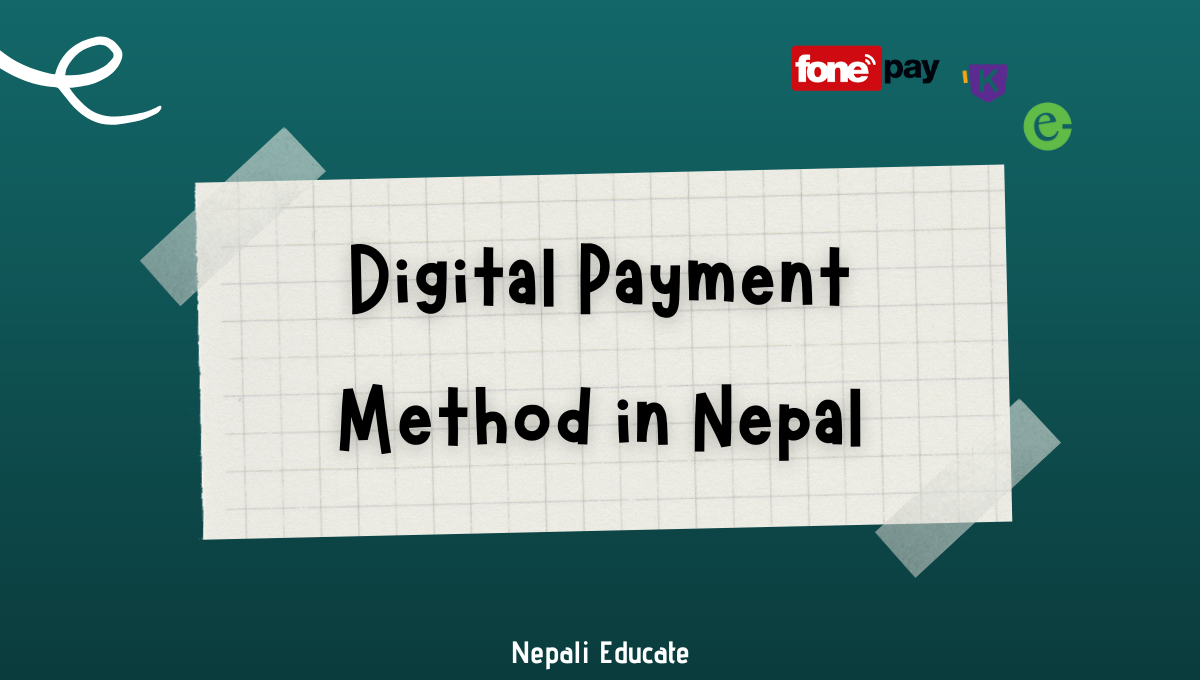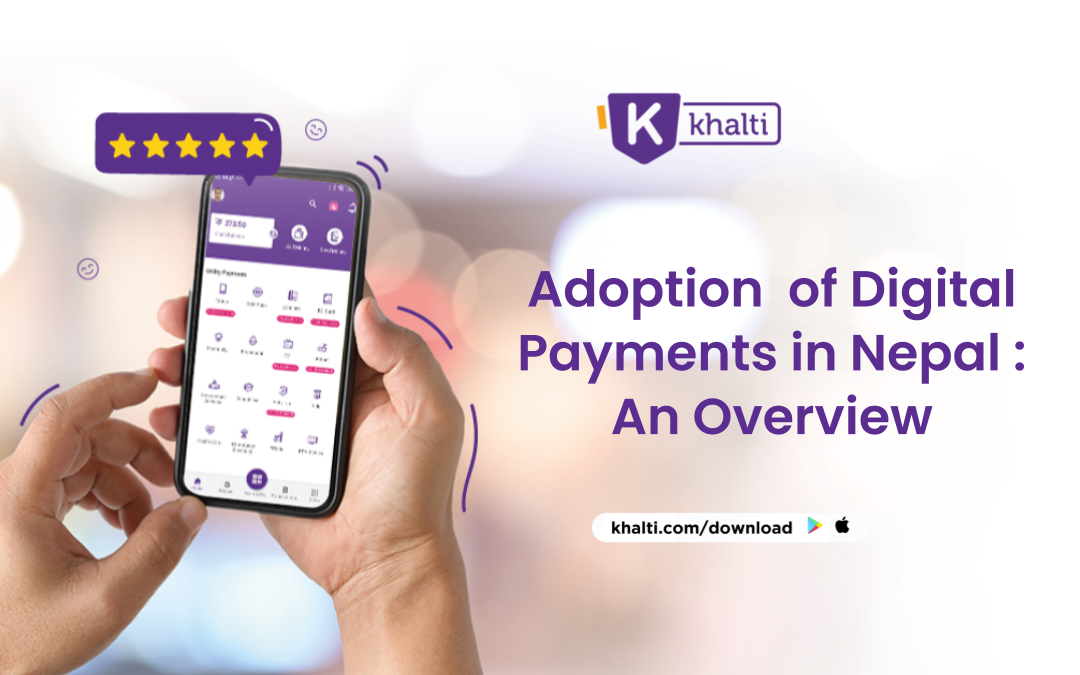

The Digital Payment System in Nepal: From Cash to Cashless Economy
6 minute read, by animesh shrestha | october 9, 2023.
Introduction
It has been more than a decade since digital payments were first introduced in Nepal, with Kumari Bank being the pioneer in 2002. At present, there are more than five digital payment platforms established that have been operating digital payment services. Similarly, the majority of banks have e-banking services as well. We can also see the growing number of applications relying on digital payments for the exchange of goods and services. Nepal’s journey from a traditional cash-based economy to a burgeoning digital payment ecosystem is a remarkable transformation that holds significant implications for the nation’s economic development; with Nepal Rastra Bank (NRB) reporting significant growth in digital transactions. Between Mid July 2021-Mid August 2021 , the NRB recorded approximately 1.3 million QR-based payments, totaling NPR 5.1 billion. Fast forward to 2023, and this figure has surged to 11.2 million transactions, amounting to approximately NPR 30 billion , marking a sixfold increase in just two years. This exponential growth underscores the remarkable journey of Nepal’s digital payment system, driven by the concerted efforts of various stakeholders.
Historical Perspective
The roots of Nepal’s digital payment revolution can be traced back to a time when the country operated with a dual currency system , with Indian currency (INR) coexisting alongside the Nepali rupee. The establishment of the NRB in 1956 marked a pivotal moment as it aimed to eliminate the dual currency system and instill confidence in the Nepali rupee. This laid the foundation for the modern payment system that would gradually evolve in the coming decades.
The advent of information technology, particularly the discovery of personal computers and the internet in the 1980s and 90s, along with a more liberalized economic regime adopted in the 1990s, created an environment conducive to digitalization. During this period, Nepal’s banking industry embraced innovation by introducing card-based payment systems , internet banking, and SMS banking, facilitating the transition from a cash-dependent economy to a cashless one.
However, this transition was not without its early challenges, including limited digital literacy, infrastructure constraints, and regulatory complexities. Despite these hurdles, the adoption of digital financial services began to gain momentum.
Factors Driving the Digital Payment Revolution
The digital payment revolution in Nepal has been propelled by several key factors. Government policies and historical initiatives have played a crucial role in promoting digital payments, aligning with the NRB’s mandate to develop a secure and efficient payment system. This commitment to infrastructure development led to the establishment of the Nepal Clearing House Limited (NCHL) in 2008, which facilitated clearing and settlement operations.
The Nepal Payment System Development Strategy (NPSDS), formulated with assistance from development partners in 2014, set the stage for integrated and strategic development of the national payment system. The creation of the Payment System Department (PSD) in 2015 within the NRB further emphasized the importance of formulating policies, issuing licenses to Payment System Operators (PSO), and regulating and inspecting PSOs and Payment System Providers (PSP).
The government’s Digital Nepal Framework (DNF) in 2019 identified eight priority sectors, including finance, and provided a roadmap to unlock growth potential. With the implementation of systems like the Treasury Single Account (TSA) and Sub National Treasury Regulatory Application (SuTRA), the government has made significant strides in electronic fund transfers.
The digital financial ecosystem that has emerged in Nepal consolidates digital infrastructure and resources into a synchronized platform, enhancing financial inclusion, reducing gender gaps, and empowering vulnerable populations. It also fosters transparency, good corporate conduct, and prudent regulatory mechanisms, making it a prerequisite for sustainable economic development.
Cross-Border Initiatives
Nepal’s digital payment revolution has not been limited to its borders. Nepal and India are set to launch a cross-border digital payment system. The first phase of this initiative, a person-to-person fund transfer system, is expected to go live by November 2023 . This system will simplify financial transactions between the two neighboring countries for business people, students, and tourists.
Furthermore, Nepal is extending its digital payment partnerships beyond its borders. In June, Fonepay signed a memorandum of understanding with Sri Lanka’s National Payment Network: LankaPay, to develop an interoperable digital payment system enabling seamless transactions between the two countries.
Chinese digital payment service WeChat Pay has also made inroads into Nepal, allowing Chinese nationals visiting the country to make payments using their mobile devices. While currently limited to Chinese visitors, this initiative demonstrates the global reach of digital payment systems.
Future Challenges
While Nepal’s digital payment ecosystem has made remarkable strides, it still faces several challenges. Cybersecurity concerns and the need to protect data privacy remain paramount. Additionally, promoting digital literacy and awareness, especially in remote regions, is essential to ensure that all segments of the population can participate in the digital economy.
Expanding digital payment initiatives across borders and addressing regulatory challenges will be vital for sustained growth. Nepal has the potential to become a hub for cross-border digital transactions, further enhancing its role in the regional economy.
Predicted growth indicates a promising future for Nepal’s digital payment ecosystem, but addressing these challenges and seizing opportunities will be crucial for realizing its full potential.
The Positive Aspect
Amidst the transformative journey of Nepal’s digital payment ecosystem, emerges a significant positive aspect. Recent data showcases a remarkable surge in mobile and broadband penetration, indicating the beneficial impact of the digital payment revolution on the country’s financial landscape. Mobile money transactions, in terms of value, have witnessed substantial growth , surging from a modest 1.47 percent of GDP in 2019 to a substantial 10.97 percent in 2021. This notable increase signifies a growing acceptance and reliance on mobile-based financial transactions among Nepali citizens. Moreover, the expansion of the population with at least one deposit account in the Nepali financial system is a promising development. This metric rose from 60.9% to 67.3% during the period spanning 2019 to 2021, as per the Financial Access Report of 2021 . This growth reflects a broader financial inclusion trend, as more individuals, particularly those in underserved areas, gain access to formal financial services through digital channels.
Further indicators of the digital payment revolution’s impact include the proliferation of payment service providers, an increased number of wallet users, a growing customer base for internet and mobile banking services, a rise in point-of-sale and card-based payments, and an expanding adoption of QR-based payments. All of these trends collectively underscore the deepening of digital payment usage and the adoption of digital financial instruments by Nepali consumers.
Way Forward
To sustain and accelerate the digital payment revolution in Nepal, a collaborative effort is needed from all stakeholders. Policymakers should prioritize investment in digital infrastructure, streamline regulatory processes, and promote digital financial literacy. Private sector players must continue to innovate, reduce transaction costs, and enhance interoperability.
Individuals, as the ultimate end-users, should embrace digital services while taking necessary precautions to protect their financial transactions. The momentum of the digital payment system in Nepal offers a promising path towards a complete digital ecosystem that can drive sustainable economic development. Continued support, innovation, and international cooperation will be key to overcoming future challenges and maximizing the benefits of digital payments in Nepal.

Animesh Shrestha is a recent A-Level graduate from Little Angels College. He is currently working at Nepal Economic Forum as an intern wherein his interest lies in development economics, macroeconomics, and international relations.
<NEFTakes
Related post.

Reimagining Thailand-Nepal Partnerships: A New Era for Business and Investment

The Power and Influence of Social Media on Local Economy and Tourism

Promoting a Family-Friendly Environment for Sustainable Population Dynamics

The Role of MSMEs in Nepal’s Transition to Sustainable Practices

The Aftermath of the Deluge: A Wakeup Call for Disaster Readiness
Nepali Educate - Educational Resources for Class 11 & 12 Students
Essay on digital payment method in nepal.
Digital payment methods have become an integral part of our lives in recent years, and Nepal is no exception to this trend. With the increasing use of smartphones and the internet, digital payments have gained popularity as an alternative to traditional payment methods in Nepal. In this essay, we will discuss the digital payment methods that are popular in Nepal and their impact on the country's economy.

One of the most popular digital payment methods in Nepal is mobile banking. Mobile banking allows users to perform banking transactions through their mobile phones. It has gained popularity in Nepal due to its convenience and accessibility. Many banks in Nepal offer mobile banking services, including Nabil Bank , Nepal Investment Bank , and Nepal SBI Bank . Users can transfer money, pay bills, and even apply for loans through their mobile phones.
Internet banking is another popular digital payment method in Nepal. It allows users to perform banking transactions online through a secure internet connection. Internet banking is widely used in Nepal for online shopping, bill payments, and fund transfers. Many banks in Nepal offer internet banking services, including Himalayan Bank, Standard Chartered Bank, and Nepal Bangladesh Bank.
E-wallets have also gained popularity in Nepal in recent years. An e-wallet is a digital wallet that stores users' payment information, such as credit and debit card details, and allows them to make purchases and payments online. E-sewa , Khalti , and IME Pay are some of the popular e-wallets in Nepal. These e-wallets can be used to pay utility bills, buy movie tickets, and make online purchases.
The adoption of digital payment methods in Nepal has had a positive impact on the country's economy. It has helped to increase financial inclusion and reduce the reliance on cash transactions. Digital payments have also helped to increase the efficiency of financial transactions, reduce costs, and improve the speed of transactions. This has made it easier for businesses to operate and for people to conduct their daily transactions.
In conclusion, digital payment methods have gained popularity in Nepal in recent years. Mobile banking, internet banking, and e-wallets are some of the popular digital payment methods in Nepal. The adoption of these payment methods has had a positive impact on the country's economy, increasing financial inclusion and reducing the reliance on cash transactions. The government and the central bank should continue to promote digital payments to further increase their adoption in the country.
Post a Comment
- Culture & Lifestyle

- Madhesh Province
- Lumbini Province
- Bagmati Province
- National Security
- Koshi Province
- Gandaki Province
- Karnali Province
- Sudurpaschim Province
- International Sports
- Brunch with the Post
- Life & Style
- Entertainment
- Investigations
- Climate & Environment
- Science & Technology
- Visual Stories
- Crosswords & Sudoku
- Corrections
- Letters to the Editor
- Today's ePaper
Without Fear or Favour UNWIND IN STYLE

What's News :
- Flower business in Tihar
- Hong Kong International Sixes
- Gai puja, Govardhan puja
- Nepal Sambat 1145 begins
- Middle East conflict
How the pandemic helped accelerate shift to digital payments

Krishana Prasain
Digital payments swelled by 18 percent year-on-year in the final month of the last fiscal year to cross the Rs6 trillion mark, which experts say is a sign of electronic transactions gaining traction.
According to the central bank, digital payments for goods and services during the period mid-June to mid-July 2022 amounted to Rs6.22 trillion.
In the previous fiscal year 2020-21, digital payments during the same one-month period totalled Rs5.26 trillion, almost double the Rs2.76 trillion in fiscal 2019-20.
Transactions normally surge during the last month of the financial year as businesses and individuals rush to clear their bills and taxes.
The rise of the digital economy has been one of the most significant fallouts of the Covid pandemic , which changed the way Nepalis make payments as they were forced to remain indoors, experts said.
Nepal Rastra Bank said the number of transactions soared to 71.42 million during the review period, up from 48.54 million transactions during the period mid-June to mid-July 2021.
“First, the Covid-19 pandemic boosted payments through digital means. Now, the central bank has launched various policies to promote digital transactions, and the result is becoming visible,” said Guru Prasad Poudel, executive director of Nepal Rastra Bank.
Payments made through the quick response (QR) system have grown steeply.
According to Nepal Rastra Bank, 4.28 million transactions were made through the QR payments system, with a total value of Rs14.52 billion in the final month of the last fiscal year.
“The central bank has made clear provisions for wallet and internet banking. It has also eased the process for utility payments that has boosted demand for electronic payment systems across the country,” Poudel said.
"The central bank has established its own real-time settlement for retail payments."
A separate department was set up for the digital payment service in 2018.
Nepal Clearing House , a dedicated institution that is involved with digital payments, was also established to facilitate payment modes.
The central bank owns 10 percent of Nepal Clearing House while the rest of the stock is held by banks and financial institutions.
“We are seeing a sharp transformation among people from traditional payment modes to digital,” Poudel said.
The government’s Digital Nepal Framework 2019 concept also supports payments over the internet to create the ecosystem, he said.
The national payment switch started functioning in November last year after Nepal Clearing House obtained operation approval from Nepal Rastra Bank.
The payment gateway brings together banks and digital payment vendors allowing them to transfer money. As part of the first phase, 29 banks and financial institutions have been affiliated with the national payment switch.
“Our target is to complete the work on the national payment switch quickly,” Poudel said. "A delay has occurred, but the work is going on."
In the second phase, Nepal Clearing House will work on a national cards system; and in the third phase, all domestic electronic transactions will be routed through the national payment switch, as per the company.
Currently, domestic Visa and MasterCard transactions are switched through international payment gateways and are charged in dollars per transaction.
But with the implementation of the national payment switch, the card payment switch will be made inside the country which will reduce charges, and make transactions faster and more convenient, according to central bank officials.
Upendra Poudyal, chairman of Nabil Bank, said that digital literacy had boosted the number of electronic transactions.
"But still, users need to be made aware about making payments securely," Poudyal said. "Banks and financial institutions also need to verify their systems time and again."
A breakdown of the online payments shows that 81,817 transactions worth Rs4.34 trillion were made through real-time gross settlement during the period mid-June to mid-July of the last fiscal year. During the same period of the previous fiscal year, there were 59,655 transactions worth Rs3.1 trillion.
Real-time gross settlement or RTGS is an electronic form of funds transfer where the transmission takes place on a real-time basis.

After RTGS, interbank payments accounted for 1.32 million transactions worth Rs275.75 billion. During the same period in the previous fiscal year, there were 1.16 million payments worth Rs299 billion.
ConnectIPS accounted for 4.27 million transactions worth Rs369.22 billion, up from 3.2 million transactions worth Rs237.75 billion in the previous fiscal year.
Internet banking transactions accounted for 318,598 transactions with a total value of Rs15.63 billion. There were 329,523 transactions worth Rs13.83 billion previously.
Bankers say that due to the rise in mobile banking transactions, the number of internet banking transactions has dropped.
Mobile banking transactions amounted to 20.56 million, posting a total value of Rs163.25 billion in the review period, a sharp increase from 13.70 million transactions worth Rs73.72 billion in the previous fiscal year.
The wallet system saw 16.20 million transactions with a total value of Rs17.75 billion, up from 12.51 million transactions with a total value of Rs12.79 billion previously.
The rising number of smartphone users and increasing internet penetration has boosted digital payments overall.
According to the management information system report of the Nepal Telecommunications Authority, there were 38.13 million internet subscribers in the country as of mid-June 2022, with broadband penetration reaching 130.63 percent of the total population.
According to Nepal Rastra Bank, 1.17 million points of sales transactions worth Rs5.18 billion were made in a single month from mid-June to mid-July. There were 635,599 transactions worth Rs2.66 billion in the same period of the previous fiscal year.
Nepalis made 68,944 e-commerce transactions worth Rs504 million using cards.
“Nepal aspires to become a cashless society and will gradually move to achieve this goal. It may take years or decades,” said Poudyal. “But a complete cashless society is not possible because there will still be people who feel safe only when they have cash in their hands.”
Krishana Prasain Krishana Prasain is a business reporter for The Kathmandu Post covering markets. Before joining The Kathmandu Post in 2018, she spent 3 years in New Business Age magazine covering business.
Related News

Nepal at risk: Malaria and dengue could spread due to climate change

NEPSE this week


Tihar gifts become dearer as dry fruits prices skyrocket

Global IME Bank and Instant Cash sign partnership agreement

Hyatt Regency Kathmandu organises breast cancer awareness walkathon

Nepal’s first consumer court to start hearing cases in December
Most read from money.

Kathmandu airport’s reduced hours send airfares into orbit

Come December, international air travel liability limits are set to rise

How round chilli has changed farmers’ lives in Palpa

Deepak Gautam: Baglung’s master baker

NIMB unveils Nepal’s first visa wearable sticker
Editor's picks.

Mobile screens are stealing family time and harming children

The rot inherent to the republic

PM Oli’s petty streak
E-paper | november 02, 2024.
- Read ePaper Online
Adoption of Digital Payment in Nepal: An Overview
by Samir Bhatta | Dec 19, 2021 | Fintech Trends | 0 comments

Digital payment is the transfer of value from one payment account to another using digital devices such as a mobile phone, POS, a computer or a digital channel. In Nepal, popular means of digital payment are Digital wallets and payment Gateway, e-banking, mobile banking, plastic cards, Automated Teller Machines, Point of Sales Machines and many more. Digital payment today has become a part of day- to-day life for most people in Nepal.
Digital payment in Nepal does not have a long history. It dates back to the early 1990’s when Nabil bank introduced credit cards. Few other banks like Himalayan Bank, Kumari Bank and Laxmi bank gave the phenomena a push by adding services related to it.
Later on with the increasing accessibility of the internet in Nepal, people are starting to use more digital payments. It is not surprising that Nepal has been adopting the technologies, being an open economy. So we can conclude the increment of digital payments and digital payment services is a part of globalization. Today all digital wallets like Khalti, IME Pay, eSewa and others have become more trendy. They are more user friendly and convenient to pay any online utility bill payment , domestic Flight booking , online Recharge and Top Up , online movie booking and many more.
People have become more familiar with digital payments after Covid-19 as the rules for social distancing have been implemented. Due to the fear of infection people avoided staying in queue to pay the bills and shop physically. As an alternative to that, they have found online payments, and online shopping more convenient, secure and time saving.
Looking at the statistics, 10.15 million out of around 30.25 million account holders are using mobile banking services whereas internet penetration in Nepal is approx. 21.4% of population. Similarly, digital payments amounted to 40% of online sales post COVID. This shows the number of digital payments has increased by almost double post covid.
Digital Wallets are definitely the trendiest of all now, because of its flexibility, security, convenience, and widespread availability. In terms of Nepal, e-wallets have reduced geographical barriers for financial transactions for people in remote areas, and given them value of time. It implies equally in the urban population too as people have a limited time frame and with a wide range of services from e-wallets a consumer can save a lot of time and be more productive and efficient.
Khalti Digital Wallet and Payment Gateway has been a part of this revolution. Starting its journey from 2017 with a small investment to growing as a big corporate house in 2021, within a few years it has contributed a lot for the digital payment industry in Nepal. With a user base of more than 2 Million, Khalti is one of the prominent companies in the industry.
You can easily book your Flight, pay insurance premium , Utility bills, Top-up and transfer and receive your amount easily with Khalti. Grab flat cashback up to Rs.100 on your every first transaction by using Coupon Code.
Also read: Khalti मा iPhone 13 साथै दैनिक १ लाख Khalti Points – मात्र रु. 50 मा जित्ने हैन त?
Don’t have a Khalti account? Download now!
For more updates about Khalti’s campaign, events, services, and offer, you can also follow us on our official Facebook page, Youtube , Twitter , Viber , Linkedin , and Instagram.
Popular on Khalti Blog Now:
Submit a comment cancel reply.
You must be logged in to post a comment.
Category: [xyz-ips snippet="Single-Category-Title"]
Transactions Made Effortless.
Download App for Free
Recent Posts
- Assistant Manager – Finance & Accounts
- Enterprises Sales Officer


COMMENTS
With the increasing use of smartphones and the internet, digital payments have gained popularity as an alternative to traditional payment methods in Nepal. In this essay, we will discuss the digital payment methods …
The rise of the digital economy has been one of the most significant fallouts of the Covid pandemic, which changed the way Nepalis make payments as they were forced to remain indoors, experts said.
mentioned in the NRB Act, 2002, payment system modernization effort was started in Nepal with the formulation of Nepal Payment System Development Strategy (NPSDS) in 2014. The …
Digital Payment In Nepal: An Overview And Recommendations. The outcome suggests that the digital revolution has made transactions involving less cash simple, as well …
Adopting a digital payment system in Nepal can help the economy, lessen the government burden, and increase it is earnings as well. But for the e-payment system to …
Learn how digital payment has become a part of day-to-day life for most people in Nepal, with examples of popular means and services. Khalti is one of the prominent companies in the industry, offering various features and …
Learn about the past, present, and future of digital banking and payment services in Nepal. Explore the challenges and opportunities of digital banking in the country and the role of eSewa as a digital wallet provider.